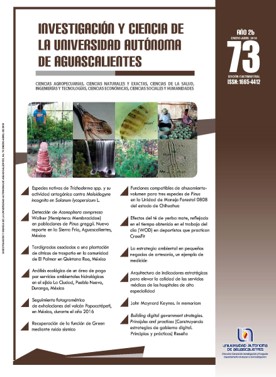Recuperación de la función de Green mediante ruido sísmico
DOI:
https://doi.org/10.33064/iycuaa201873206Palabras clave:
relación de Poisson, ondas sísmicas, correlaciones de movimientos, sismogramas sintéticos, sismogramas recuperados, energía sísmicaResumen
Recientemente se ha demostrado que la recuperación de la función de Green puede realizarse a partir de ruido sísmico. Esta función es la característica fundamental del medio donde se propagan las ondas sísmicas. En este trabajo se plantea una formulación –para el caso 2D- que permite la recuperación de la función de Green a partir de ruido sísmico. Se estudian varios tipos de medios homogéneos caracterizados por sus velocidades de propagación y relación de Poisson. Adicionalmente, para el caso bidimensional, donde se propagan solamente las ondas P y SV, se discuten y comprueban las contribuciones de energía de correspondiente a cada tipo de onda sísmica.
Descargas
Citas
Aki, K. (1957). Space and time spectra of stationary stochastic waves with special reference to microtremors. Bulletin of the Earthqake Research Institute, 35, 415-456.
__________, & Richards, P. G. (2002). Quantitative Seismology (2a. ed.). US: University Science Books.
Campillo, M., & Paul, A. (2003). Long-range correlations in the diffuse seismic coda. Science, 299(5606), 547-549.
Garus, D., & Wegler, U. (2011). The Green’s functions constructed from 17 years of ambient seismic noise recorded at ten stations of the German Regional Seismic Network. Bulletin of the Seismological Society of America, 101(6), 2833-2842.
Liu, E., & Zhang, Z. (2001). Numerical study of elastic wave scattering by distributed cracks or cavities using the boundary integral method. Journal of Computational Acoustics, 9, 1039-1054.
Ma, S., & Beroza, G. (2012). Ambient-field Green’s functions from asynchronous seismic observations. Geophysical Research Letters, 39(6), L06301. doi: 10.1029/2011GL050755
Ryzhik, L. V., Papanicolau, G. C., & Keller, J. B. (1996). Transport equations for elastic and other waves in random media. Wave Motion, 24(4), 327-370.
Sánchez-Sesma, F. J., & Campillo, M. (1991). Diffraction of P, SV and Rayleigh waves by topographic features: A boundary integral formulation. Bulletin of the Seismological Society of America, 81(6), 2234-2253.
Sánchez-Sesma, F. J., Pérez-Ruiz, J. A., Luzón, F., Campillo, M., & Rodríguez-Castellanos, A. (2008). Diffuse fields in dynamic elasticity. Wave Motion, 45(5), 641-654.
Sato, H., & Fehler, M. C. (1998). Seismic wave propagation and scattering in the heterogeneous Earth. US: Springer-Verlag.
Shapiro, N. M., & Campillo, M. (2004). Emergence of broadband Rayleigh waves from correlations of the ambient seismic noise. Geophysical Research Letters, 31(7), L07614. doi:10.1029/2004GL019491
Van Manen, D. J., Curtis, A., & Robertsson, J. O. (2006). Interferometric modeling of wave propagation in inhomogeneous elastic media using time-reversal and reciprocity. Geophysics, 71(4), SI47-SI60.
Wapenaar, K. (2004). Retrieving the elastodynamic Green’s function of an arbitrary inhomogeneous medium by cross correlation. Physical Review Letters, 93, 254301-1-254301-4.
Weaver, R. L. (2005). Geophysics. Information from seismic noise. Science, 307(5715), 1568-1569.
__________, & Lobkis, O. I. (2004). Diffuse fields in open systems and the emergence of the Green’s function. The Journal of the Acoustical Society of America, 116, 2731-2734. doi: 10.1121/1.1810232
Descargas
Publicado
Cómo citar
Licencia
Las obras publicadas en versión electrónica de la revista están bajo la licencia Creative Commons Atribución-NoComercial-CompartirIgual 4.0 Internacional (CC BY-NC-SA 4.0)









